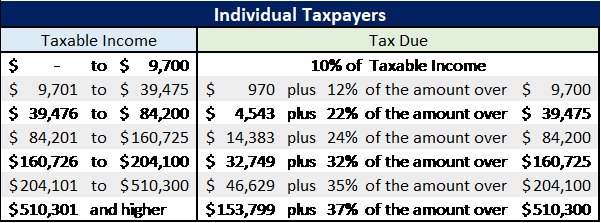

Knowing your marginal tax bracket can also influence how you approach the available deductions, such as if you choose to use the standard deduction or itemize, and perhaps give a large lump sum to charity to reduce your taxable income, Reddy says. "Even a minimal pay increase could kick you up into a higher percentage of tax payment, as well as impact whether you qualify for things such as the child tax credit," Reddy says. Likewise, understanding which bracket you're in helps you understand any implications of how changes in your earnings will affect your overall tax burden, says Sri Reddy, senior vice president of retirement and income solutions at Principal Financial Group. If your marginal tax rate doesn't tell you how much tax you'll actually pay, why do you even need to know what it is? For one thing, it's because you can only determine your effective tax rate by calculating total tax liability. Why is it important to know my tax bracket? Your marginal tax rate is the highest tax rate your taxable income falls into. Note: Your effective tax rate is the actual percentage of taxes you pay overall. You calculate your effective tax rate by dividing your total tax liability, $7,068, by your annual taxable income, $52,050. The actual percentage you pay on the entirety of your taxable income is called the effective tax rate. So putting it all together, your total federal income tax for the year would be $7,068. $10,275 taxed at 10%, resulting in $1,028 of income taxes.

Instead, your income would be taxed as follows: But it doesn't mean you pay 22% tax on all of your earnings. That leaves taxable income of $52,050, putting you in the 22% bracket. So let's say you're an individual filer with adjusted gross income of $65,000 in 2022 and take the standard deduction of $12,950.

FEDERAL TAX BRACKET PERCENTAGES 2019 HOW TO
How to calculate your tax liability using brackets The resulting dollar amount will determine what marginal tax bracket you're in. You can also subtract adjustment such as IRA contributions and student loan interest from your adjusted gross income. Standard deductions for 2023 increase to $13,850 for single filers, $20,800 for heads of households, and $27,700 for married couples. For married couples filing jointly, the 2022 standard deduction is $25,900. The standard deduction for the 2022 tax year is $12,950 for single filers and married individuals filing separately. You can choose to take the standard deduction for the year or use itemized deductions. From this income, you can take deductions and adjustments to reduce your taxable income, and thus lower your tax bracket. Klein, founder and chief investment officer at ALINE Wealth. "Your tax bracket is evaluated by viewing all your income, including required minimum distributions (RMDs) from IRAs, Social Security and possibly even a pension if you are fortunate to have one," says Peter J. Yours will depend on your income level and filing status. There are seven brackets for 20, ranging from 10% to 37%. The rate they pay on the last dollar is known as the marginal tax rate. In fact, they would only pay that much on the upper-most portion of it. However, a common misperception is that someone whose total taxable income puts them into, say, the 22% tax bracket means that they pay 22% on all of their money. You can use tax brackets to estimate how much you'll pay in taxes for the year. To determine the tax someone owes, the government uses a system of brackets, where different chunks of a person's earnings are taxed at rates that get gradually higher as the total amount of income increases. The US uses a progressive federal income tax system.


 0 kommentar(er)
0 kommentar(er)
